Ducks in a Row (Part 1)
Part
II now available
In the 1960s The Italian firm of Ducati made a fine line of
small displacement motorcycles which fit perfectly in the
American market which at that time was hungry for lightweights.
Although the lightweight craze was started by the Japanese
(remember the advertizing slogan: you meet the nicest people on a
Honda?), Europe was quick to cash in on it. Still struggling out
of the economic hole called Word War II, the Italians
manufactured many fine lightweight motorcycles for economical and
practical transportation. These just happened to be ideal for the
exploding American market and were exported for badly needed US
dollars. Gillera found Sears Robuck, Benelli found Montgomery
Ward and Ducati found Berliner Motors as their US importers. The
Ducati firm was started in 1926 by three brothers in Bologna
Italy manufacturing domestic appliances. In 1946 the firm
expanded into cycles with a 48 cc 4 stroke moped called the Cucciolo . In the early 50s a young
engineer named Fabio Taglioni joined the company and developed
the 98cc Gran Sport. It was a bevel-gear driven overhead cam
single which was the prototype for the Ducatis for the next 30
years. The Ducati singles were quite sporty for their time with a
single overhead camshaft on all models. In the pushrod 60's they
stood alone. Capacities ranged from 160cc to 450cc in size.
 I had done a clean up on a 1962 250cc Monza about
8 years ago which I gave to my 16 year-old son to ride. As he, of
course, used it for real transportation and because he had no
fond memories of the marquee, he soon asked if he could trade it
for a Honda Rebel. I agreed and the Monza went with a happy
collector to Chicago. I always swore if I found another Ducati
single I would not part with it. Last fall I found not 1 but 3
Ducati singles with long-time motorcycle restorer and collector
Carlos Forte here in Mobile. He coveted a Moto Guzzi V7 that I
was trying to sell and so a deal was struck for a very rusty but
complete 1966 Sebring 350 plus some cash coming my way. Two weeks
later Jim Arrington made a deal with Carlos for the second
Ducati, a white 250 cc scrambler model with very little sheet
metal but a motor that ran very well. So there we were, in the
Ducati restoring business.
I had done a clean up on a 1962 250cc Monza about
8 years ago which I gave to my 16 year-old son to ride. As he, of
course, used it for real transportation and because he had no
fond memories of the marquee, he soon asked if he could trade it
for a Honda Rebel. I agreed and the Monza went with a happy
collector to Chicago. I always swore if I found another Ducati
single I would not part with it. Last fall I found not 1 but 3
Ducati singles with long-time motorcycle restorer and collector
Carlos Forte here in Mobile. He coveted a Moto Guzzi V7 that I
was trying to sell and so a deal was struck for a very rusty but
complete 1966 Sebring 350 plus some cash coming my way. Two weeks
later Jim Arrington made a deal with Carlos for the second
Ducati, a white 250 cc scrambler model with very little sheet
metal but a motor that ran very well. So there we were, in the
Ducati restoring business.
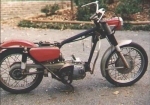 My motor was sans a top end as you
can see by the rod protruding from the case. The head was in the
parts pile but missing a tooth in the bevel gear. There was also
a piston but no cylinder. However, the deal included a complete
spare motor of unknown condition. Disassembly of the spare motor
revealed a badly burnt piston but a good cylinder and head. Even
better, the cylinder was standard and matched the piston in the
other motor. I ordered some parts and a shop manual, from Domi Racer who seemed to have
everything I needed. A quick lap of the valves, a honing of the
cylinder, new valve seals and rings and the top-end was back
together. I also had to put a helicoil in the stripped spark plug
hole.
My motor was sans a top end as you
can see by the rod protruding from the case. The head was in the
parts pile but missing a tooth in the bevel gear. There was also
a piston but no cylinder. However, the deal included a complete
spare motor of unknown condition. Disassembly of the spare motor
revealed a badly burnt piston but a good cylinder and head. Even
better, the cylinder was standard and matched the piston in the
other motor. I ordered some parts and a shop manual, from Domi Racer who seemed to have
everything I needed. A quick lap of the valves, a honing of the
cylinder, new valve seals and rings and the top-end was back
together. I also had to put a helicoil in the stripped spark plug
hole.
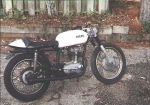 The bottom end looked awful but
really was in good shape. Two of the holes where the head bolts
scew into the case were stripped and needed helicoils but the rod
and cam drive bearings were good. The insulation on the wires
from the alternator would crumble to the touch so I had to open
the primary case to replace them. That gave me a chance to check
out the clutch and main bearings. All of that looked great.
The bottom end looked awful but
really was in good shape. Two of the holes where the head bolts
scew into the case were stripped and needed helicoils but the rod
and cam drive bearings were good. The insulation on the wires
from the alternator would crumble to the touch so I had to open
the primary case to replace them. That gave me a chance to check
out the clutch and main bearings. All of that looked great. 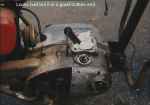 Unfortunately, the stator was located below a
flywheel which is on a tapered shaft and requires a very unusual
puller. I didn't have one and couldn't locate one. Fortunately,
the wires inside the case were not so deteriorated so I spliced
them with solder and some heat shrink tubing rather than take a
chance on ruining the flywheel trying to remove it without the
puller. On Jim Arrington's 250 someone had drilled two 5/16"
holes in the flywheel so you could use a steering wheel puller to
get it off. Obvious a good idea. If one drilled at the 12 o'clock
position just outside the steel hub you would miss the stator
coil and the magnets and could tap the holes in situ. We were
able to solder the wires directly on the stator on Jim's motor.
Unfortunately, the stator was located below a
flywheel which is on a tapered shaft and requires a very unusual
puller. I didn't have one and couldn't locate one. Fortunately,
the wires inside the case were not so deteriorated so I spliced
them with solder and some heat shrink tubing rather than take a
chance on ruining the flywheel trying to remove it without the
puller. On Jim Arrington's 250 someone had drilled two 5/16"
holes in the flywheel so you could use a steering wheel puller to
get it off. Obvious a good idea. If one drilled at the 12 o'clock
position just outside the steel hub you would miss the stator
coil and the magnets and could tap the holes in situ. We were
able to solder the wires directly on the stator on Jim's motor.
The next problem was two twisted-off bolts on the right timing
cover. I spent two days tending to those bolts. Nothing is more
unpleasant than removing twisted-off bolts but somehow they
eventually all seem to come out. One required a helicoil, however
to repair the threads.
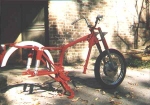 The painting was done over Christmas
vacation. I had decided on silver trim and a red frame. Domi
Racer had the tank decals but nothing for the side cover. I had a
good picture to go by for the trim. After a complete disassembly
I took all of the steel parts down to the bead blaster place and
they were soon gleaming bare metal. The frame was done in red RM
brand synthetic enamel with a polyurethane hardener. The front
fender was in terrible shape with many cracks and lots of dents.
I brazed some 1/16" steel behind the cracks and straightened
out things as best I could. Some bondo filled the remaining dents
and soon the fenders were passable. I used a silver base
coat/clear coat from RM that went on well. After base coat I used
Scotch pinstripe tape to approximate the original trim and placed
the decals on the tank. I then clear coated over the tape and
decals. This make for a nice finish. I went to a local sign shop
and after showing them a photograph in the shop manual they came
up with some very passable art work for the side covers. A-1 Auto
Interiors here in Mobile (334 380 9262) redid the seat for $65
and it came out perfectly.
The painting was done over Christmas
vacation. I had decided on silver trim and a red frame. Domi
Racer had the tank decals but nothing for the side cover. I had a
good picture to go by for the trim. After a complete disassembly
I took all of the steel parts down to the bead blaster place and
they were soon gleaming bare metal. The frame was done in red RM
brand synthetic enamel with a polyurethane hardener. The front
fender was in terrible shape with many cracks and lots of dents.
I brazed some 1/16" steel behind the cracks and straightened
out things as best I could. Some bondo filled the remaining dents
and soon the fenders were passable. I used a silver base
coat/clear coat from RM that went on well. After base coat I used
Scotch pinstripe tape to approximate the original trim and placed
the decals on the tank. I then clear coated over the tape and
decals. This make for a nice finish. I went to a local sign shop
and after showing them a photograph in the shop manual they came
up with some very passable art work for the side covers. A-1 Auto
Interiors here in Mobile (334 380 9262) redid the seat for $65
and it came out perfectly.
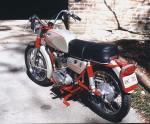 I had good rims on the wheels but
the spokes were rusty. I broke down the wheels, cleaned the hubs
and rims and with new stainless steel spokes from Buchanan's
Frame Shop (626 969 4655) put the wheels back together. A couple
new tires, a battery, and a chain from J.C. Whitney finished the
job. I bolted it all together (new bolts of course) and it looked
great. When I went to tighten the left petcock in the tank,
however, its seat broke lose from the tank. Not anxious to ruin
the paint job with a brazing I tried some J.B Weld. The socket
did not actually come off the tank but rather just turned such
that gas leaked around it. I scraped the paint off and smeared
J.B.Weld around the seam and let it harden. So far it has been
solid. That stuff is great!
I had good rims on the wheels but
the spokes were rusty. I broke down the wheels, cleaned the hubs
and rims and with new stainless steel spokes from Buchanan's
Frame Shop (626 969 4655) put the wheels back together. A couple
new tires, a battery, and a chain from J.C. Whitney finished the
job. I bolted it all together (new bolts of course) and it looked
great. When I went to tighten the left petcock in the tank,
however, its seat broke lose from the tank. Not anxious to ruin
the paint job with a brazing I tried some J.B Weld. The socket
did not actually come off the tank but rather just turned such
that gas leaked around it. I scraped the paint off and smeared
J.B.Weld around the seam and let it harden. So far it has been
solid. That stuff is great!
 The bike was originally fitted with a compression
release which I scoffed at. I used to kick 74 inch Harleys.
Surely I could handle a 350 cc thumper like this one. So the
compression release was omitted. Wrong move! The little Duck only
had 8.5:1 pistons in it and I put an extra 1/16" shim under
the cylinder to further lower the compression. However, when I
stepped on that starter pedal it sometimes went down but if it
was on compression it just looked at you and said no way dude! To
further complicate it the starter is on the left and I am
strictly right-foot-kicker. It would start but it also left me
with a very sore foot and leg. After several weeks of that
nonsense I decided to install the compression release. It is
interesting that Jim's 250 is a pleasure to kick. That extra 100
cc makes a big difference. I also notice that the starter gear
mechanism is different between the 250 and the 350 which may also
explain some of it.
The bike was originally fitted with a compression
release which I scoffed at. I used to kick 74 inch Harleys.
Surely I could handle a 350 cc thumper like this one. So the
compression release was omitted. Wrong move! The little Duck only
had 8.5:1 pistons in it and I put an extra 1/16" shim under
the cylinder to further lower the compression. However, when I
stepped on that starter pedal it sometimes went down but if it
was on compression it just looked at you and said no way dude! To
further complicate it the starter is on the left and I am
strictly right-foot-kicker. It would start but it also left me
with a very sore foot and leg. After several weeks of that
nonsense I decided to install the compression release. It is
interesting that Jim's 250 is a pleasure to kick. That extra 100
cc makes a big difference. I also notice that the starter gear
mechanism is different between the 250 and the 350 which may also
explain some of it.
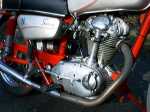 The bike had a box of carburetor parts with it. In
it were parts from 2 Delorto carbs plus I had a 3rd
Delorto I had rescued from a Moto Marini moped in the junk yard..
An afternoon of trial and error produced one pretty good working
carburetor. When started, however, the motor was quite noisy.
Furthermore, when it came up to temperature it did not want to
idle and almost acted like it was starting to seize. I
immediately worried about the oil pump. I had taken the pump
apart during the twisted bolt removal operation. While it looked
ok there was no way to really test if it was oiling. I took off
one of the oil return lines from the head and started the engine.
Sure enough, not a drop was flowing. In the Ducati the oil pump
is in the timing cover on the right side of the engine. It runs
off an idler gear below the crankshaft and is a gear-type pump.
Oil goes through passages in the cover to a bushing in which the
crankshaft end runs. That directs some of the oil through the
crankshaft passages to the rod bearing. The rest of the oil then
passes to the top of the timing cover where it then traverses the
crankcase to the left side and then up through a passage in the
cylinder to the head.
The bike had a box of carburetor parts with it. In
it were parts from 2 Delorto carbs plus I had a 3rd
Delorto I had rescued from a Moto Marini moped in the junk yard..
An afternoon of trial and error produced one pretty good working
carburetor. When started, however, the motor was quite noisy.
Furthermore, when it came up to temperature it did not want to
idle and almost acted like it was starting to seize. I
immediately worried about the oil pump. I had taken the pump
apart during the twisted bolt removal operation. While it looked
ok there was no way to really test if it was oiling. I took off
one of the oil return lines from the head and started the engine.
Sure enough, not a drop was flowing. In the Ducati the oil pump
is in the timing cover on the right side of the engine. It runs
off an idler gear below the crankshaft and is a gear-type pump.
Oil goes through passages in the cover to a bushing in which the
crankshaft end runs. That directs some of the oil through the
crankshaft passages to the rod bearing. The rest of the oil then
passes to the top of the timing cover where it then traverses the
crankcase to the left side and then up through a passage in the
cylinder to the head.
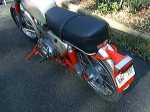 The timing cover came off the engine again and I
tried to blow air through the line to the head. Nothing - it was
stopped up! I then removed the head (by the way there is no head
gasket on a Ducati, just aluminum against aluminum). I blew air
down through the cylinder passage and a glob of gasket compound
shot across the room. When the case halves had last been joined
the mechanic had made liberal use of gasket compound and in so
doing had unwittingly plugged the oil passage to the head. That
explains why the head that was on this engine has a broken bevel
gear. It had been run dry until it melted the cam gears.
Fortunately, the passage to the bottom end was open and the con
rod had received the entire pump's output and was happy. By the
way, the Ducati has a roller bearing big end sort of like a
Harley. While I am primarily a British bike fan, I must
congratulate the Ducati factory for the superb workmanship that
is evident throughout this fine engine. It is well thought out
and beautifully executed. Nothing like the British junk I am used
to seeing.
The timing cover came off the engine again and I
tried to blow air through the line to the head. Nothing - it was
stopped up! I then removed the head (by the way there is no head
gasket on a Ducati, just aluminum against aluminum). I blew air
down through the cylinder passage and a glob of gasket compound
shot across the room. When the case halves had last been joined
the mechanic had made liberal use of gasket compound and in so
doing had unwittingly plugged the oil passage to the head. That
explains why the head that was on this engine has a broken bevel
gear. It had been run dry until it melted the cam gears.
Fortunately, the passage to the bottom end was open and the con
rod had received the entire pump's output and was happy. By the
way, the Ducati has a roller bearing big end sort of like a
Harley. While I am primarily a British bike fan, I must
congratulate the Ducati factory for the superb workmanship that
is evident throughout this fine engine. It is well thought out
and beautifully executed. Nothing like the British junk I am used
to seeing.
The final problem was the shifter. It would not always shift
into 1st gear. Normally shift problems means splitting
the cases but not on a Duck. The shifter mechanism is entirely in
the right rear cover over the sprocket. It pops off with a few
bolts and a quick check revealed rounded shifter pawls. The cover
on the spare engine had sharp ones so I made one good one out of
the two. Now it shifts great.
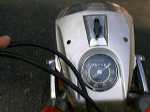 How does it run? Oddly enough the
350s did not have the performance that one might expect. The
manual lists 89 mph as top speed even though it has a 150 mph
speedo. I am not sure mine would even make 79. The 250 cc Mach I
of the same year had 10:1 pistons, a 30 mm carb and a hot cam and
was rated at 110 mph, 30 MPH faster. The 350 was not offered in a
hot version. Nevertheless, the Sebring has good torque and the
five speeds in the transmission make it a nice ride. It hums
along at 60mph just fine. It is light for a 350 and when astride
of it you feel more like you are on about a 200 cc bike. It does
handle well, however, and the vibration is not bad for a single.
How does it run? Oddly enough the
350s did not have the performance that one might expect. The
manual lists 89 mph as top speed even though it has a 150 mph
speedo. I am not sure mine would even make 79. The 250 cc Mach I
of the same year had 10:1 pistons, a 30 mm carb and a hot cam and
was rated at 110 mph, 30 MPH faster. The 350 was not offered in a
hot version. Nevertheless, the Sebring has good torque and the
five speeds in the transmission make it a nice ride. It hums
along at 60mph just fine. It is light for a 350 and when astride
of it you feel more like you are on about a 200 cc bike. It does
handle well, however, and the vibration is not bad for a single.
In 2009 I traded the Ducati for a 1971 BSA thunderbolt. I was sorry to see
this beautiful piece of Italian sculpture go but it was time for a new
adventure.
In part
two we let you know how Jim Arrington makes out with his
bike.
Return to Restoration Page.
 I had done a clean up on a 1962 250cc Monza about
8 years ago which I gave to my 16 year-old son to ride. As he, of
course, used it for real transportation and because he had no
fond memories of the marquee, he soon asked if he could trade it
for a Honda Rebel. I agreed and the Monza went with a happy
collector to Chicago. I always swore if I found another Ducati
single I would not part with it. Last fall I found not 1 but 3
Ducati singles with long-time motorcycle restorer and collector
Carlos Forte here in Mobile. He coveted a Moto Guzzi V7 that I
was trying to sell and so a deal was struck for a very rusty but
complete 1966 Sebring 350 plus some cash coming my way. Two weeks
later Jim Arrington made a deal with Carlos for the second
Ducati, a white 250 cc scrambler model with very little sheet
metal but a motor that ran very well. So there we were, in the
Ducati restoring business.
I had done a clean up on a 1962 250cc Monza about
8 years ago which I gave to my 16 year-old son to ride. As he, of
course, used it for real transportation and because he had no
fond memories of the marquee, he soon asked if he could trade it
for a Honda Rebel. I agreed and the Monza went with a happy
collector to Chicago. I always swore if I found another Ducati
single I would not part with it. Last fall I found not 1 but 3
Ducati singles with long-time motorcycle restorer and collector
Carlos Forte here in Mobile. He coveted a Moto Guzzi V7 that I
was trying to sell and so a deal was struck for a very rusty but
complete 1966 Sebring 350 plus some cash coming my way. Two weeks
later Jim Arrington made a deal with Carlos for the second
Ducati, a white 250 cc scrambler model with very little sheet
metal but a motor that ran very well. So there we were, in the
Ducati restoring business.







